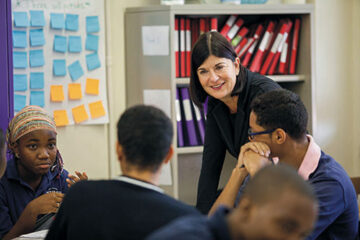Cross-posted at Education Week.
I met Rod Allen, a former associate deputy minister in the British Columbia Education Ministry, last year at a meeting of the Global Education Leaders Partnership hosted by our organization and the Harvard Graduate School of Education. Rod is now the superintendent of Cowichan Valley schools in British Columbia. His description of British Columbia’s curriculum reforms, which he had been leading, was fascinating. We called Rod last week to refresh our memory. Here’s the story.
BC decided it needed to revise its approach to learning in 2009. John Abbott—author of Overschooled but Undereducated and head of the 21st Century Learning Initiative—was an influential thought leader at the time. Convinced by Abbott and their own experience that, as Abbott put it, “they were doing a wonderful job of preparing students for a world that no longer exists,” they sensed a groundswell of support to “modernize” their approach to learning.
The province looked at their PISA results, which were world class, but they were not impressed. Something was missing. They got out of Ministry conference rooms and organized conversations all over the province with all sorts of people and asked how the people they talked to thought the schools were doing. They talked with community members, employers, educators, people from the First Nation community, educators from every level of the system, and many others, always in mixed groups so everyone could hear what everyone else was saying.
“What was notable was not only what they said, but what they did not say,” Rod noted. “They did not say our kids can’t read well enough or do math well enough. What they said was that kids don’t demonstrate grit; they are not resilient; they don’t stick to problems long enough to solve them; they don’t know how to cooperate well enough; they don’t know how to work in high-pressure teams; they don’t know how to identify a problem, articulate it and solve it; they can’t teach themselves new things.”
These were not conversations about curriculum. They were conversations intended to build a common vision for education in British Columbia.
“After the discussions around the province, we went back to the teachers,” Rod told us. “We started that discussion with them not around curriculum, but about how we fundamentally change learning. The teachers kept saying we need to address curriculum in order to do that. They said the curriculum is too long, there is too much to cover. So, we decided to start with curriculum.”
“The teachers said that this was not just a matter of finding a way to cut back a bit on some of the things they were currently responsible for teaching so a little more of something else could be crammed in,” Rod recalled. “They said that the curriculum they had to teach was too much, and we need to decide what is really important. Knowing is not enough anymore. We have to be sure they understand. We need a curriculum that focuses on understanding.”
Rod pointed out that the students’ smartphones provide ready access to all the knowledge they would ever need. The issue is whether they understand what they know and whether they can use what they understand. Rod was not dismissive about knowledge, as some modernists I know are. He understands that in order to understand anything, one has to know something in particular and so, the technology notwithstanding, it is very important to be clear about what students need to have in their brain’s memory.
From this conceptual structure, the planners derived a curriculum framework with four big compartments: 1) Core competencies: What we want students TO BE, 2) Big ideas: What we want students TO UNDERSTAND, 3) Content: What we want students TO KNOW, and 4) Curriculum competencies: What we want students TO DO.
That, of course, is fine for a broad framework, but it is not a curriculum and provides only the most general guidance for creating one. They had to figure out the right balance between the curriculum that comes down from the ministry and how much is left to the teachers to develop in their schools. And, too, where the curriculum that comes down from the ministry is developed. These questions were coupled with another: What did the planners do to get the teachers on board? All these questions seemed linked. So were the answers.
I’ll start with the answer to the last of these three questions and swing back to the answers to the others.
The planners had a problem. They did not want the curriculum to be highly prescriptive. It was in the very essence of the idea that teachers needed to be creative and to have the scope they would need to work not to the letter of the law but in the spirit of the reforms the planners were trying to bring about. But what they wanted to bring about was very different from what teachers were doing. The answer, they thought, was to have teachers develop the new curriculum working under the auspices of the ministry. Neither the ministry nor the teachers would develop the curriculum. It would be co-developed by both. That way, both would own it. And that is exactly what happened.
It wasn’t easy. It turns out that, when this work began, the relationship between the BC government and the teachers union was more or less one of open warfare. But, when the planners in the ministry went to the union and said that they did not want to consult with the union, but intended instead to co-construct the new curriculum with the teachers and work in collaboration with the teachers to do it, the union accepted the offer, and a lot of trust was built, even as the tension between the government as a whole and the union got increasingly intense, eventually culminating in an extended job action. Even then, the work on the curriculum progressed.
Rod thinks they got the balance between central specification of curriculum frameworks and flexibility for teachers in implementing the new curriculum about right. Some teachers think it is too “loosey-goosey.” And some think it is too tightly specified, which makes him think it is, in fact, in the sweet spot. Everyone, he says, realizes that, especially in subjects like mathematics, where there is a natural logical progression for learning the material, that progression has to be in the curriculum. So the mathematics curriculum states, for example, that order of operations with whole numbers needs to be taught at a certain point in the progression. For each such statement, there is another set of statements that provide more detail. There are on the order of 20 to 25 such statements for each year. The same approach is taken to history, for example, but there is less detail.
This approach, of course, assumes that the issue is what is to be taught for understanding, not whether the teacher knows the subject well enough to teach for understanding. Rod pointed out that Canadian teachers can typically be counted on to have about the same level of subject matter mastery as Finnish teachers (where teachers are widely thought to be highly qualified). In both cases, all teachers are required to have five years of college and university preparation, in Finland at that country’s research universities, in British Columbia to a standard comparable to the Finnish standard. Rod clearly understands the danger of giving teachers great latitude to develop a curriculum focused on understanding if the teachers themselves don’t have a firm understanding of their subject at a fairly deep level. But the data show that Canadian teachers are among the best-educated in the world.
Subject mastery is not the only important implementation issue. Canada celebrates the diversity of its students, seeing that diversity as an asset, not a liability. The question is how to teach a curriculum focused on understanding and the application of what the student knows and understands to real world challenges.
“The fact,” Rod said, “that a student is in Grade 6 does not necessarily mean he or she has mastered all of the Grade 5 curriculum. We do not believe in retention. We go into this understanding the massive diversity in the classroom. We also practice inclusion. We want a year’s progress in a year for each student, but we know that there is diversity. But we don’t want the teacher to teach to the middle of the class. The teacher has to find a way to address the diversity. How do I deal with order of operations knowing that some kids already understand this and some won’t totally get it no matter what I do and will require me to spent extra time with them? That is a core issue of instruction.”
“The key is abandoning the idea that one is teaching the curriculum,” Rod went on. “Instead, what the teacher should be doing is creating experiences for students that will result in the outcomes we want. Those experiences will produce unexpected corners for both teacher and student. The teacher has to be prepared to say, “I don’t know. Let’s find out.””
That outlook, of course, raises some knotty questions of assessment.
“That’s evolving,” Rod said. “We can assess ‘know;’ we know how to assess ‘do.’ We’re getting better at ‘understand’, but it is a challenge to do it in a consistent way. For example: a physics class where the students are building potato guns. They have to be able to build one and then explain what they did. So, some students who did not build it well still might be able to understand what they did better than some students who built it well. Teachers listen to the conversation among the kids, and can tell who does and does not understand.”
“We have fewer traditional tests, but we still have them. It is still necessary to assess content. But we need to develop a more varied set of assessments to look at the broad range of what we need students to know and do and understand. It is still hard to get our heads around how to assess a lot of what learning needs to look at. There is not much data about competency areas like grit. We’re talking now about how to do that. We are trying to let teachers experiment with this before we set provincial policy. Before we involve the province again, we want what we are now doing to settle.”
In most countries, the high school curriculum and high school testing policy is very heavily influenced by the admissions policies and practices of the higher education institutions. We asked Rod whether that was true in this case, and, if so, whether that had been a problem.
“We made this decision with higher education,” he said. “They thought that the graduation exams were not useful in measuring what they needed to know about students. We see this as a pause, not necessarily the end of assessment. Right now higher education relies on students’ GPA and grades and some faculties have their own assessments.”
Talking to Rod, one got the feeling that the British Columbia curriculum and the transformation in learning it enables is still very much a work in progress, but a work that is being undertaken in collaboration with highly professional, very well-educated teachers who own the new curriculum in a way that will make it very difficult for a new government to change. This sense that they are comfortable with being very far from having all the answers came through most forcefully when he said, “We started with this sense of ‘unease.’ We actually used a German word—zugunruhe—that means migratory restlessness.”
I sometimes get the sense that, here in the United States, the reform is the legislation. Everything else is relatively unimportant. It is the policies that count. But not in this conversation. Here, I got the sense that policy was handmaiden to a sweeping cultural change in the schools that had been rooted in a long conversation that took place in meeting rooms all over the province and was still going on, in the schools and elsewhere.
For my part, it sounded to me as though they may not have all the answers but they have the right questions and the patience to get to good answers.





